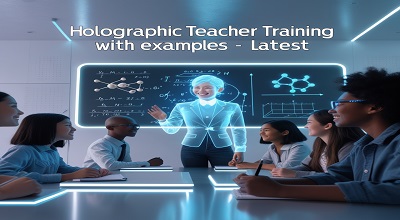Holographic Teacher Training
Holographic Teacher Training: Holographic teacher training is an innovative approach that uses holographic technology to enhance professional development for educators. Unlike traditional training methods, holograms provide an immersive, interactive, and realistic learning experience. This technology allows teachers to engage with virtual instructors, simulate classroom scenarios, and receive real-time feedback.
With advancements in augmented reality (AR) and virtual reality (VR), holographic training is becoming more accessible. Institutions worldwide are adopting this method to improve teaching techniques, classroom management, and subject expertise.
How Holographic Teacher Training Works?
Holographic teachers training relies on cutting-edge technology to create lifelike simulations. Here’s how it works:
A. Hologram Projection
- High-definition projectors or AR glasses display 3D holograms of instructors or students.
- Teachers can interact with these holograms as if they were real.
B. AI-Powered Simulations
- Artificial Intelligence (AI) generates dynamic classroom scenarios.
- Teachers practice handling disruptions, engaging students, and delivering lessons effectively.
C. Real-Time Feedback
- Sensors and AI analyze the teacher’s performance.
- Instant feedback helps refine teaching strategies.
D. Remote Collaboration
- Educators from different locations can join holographic training sessions.
- Experts provide live demonstrations and coaching.
Benefits of Holographic Teacher Training
A. Enhanced Engagement
- Interactive holograms make training more engaging than traditional lectures.
B. Realistic Classroom Simulations
- Teachers practice in lifelike environments without real-world consequences.
C. Cost-Effective Professional Development
- Reduces travel and venue costs associated with in-person training.
D. Personalized Learning
- AI tailors training modules based on individual teacher needs.
E. Accessibility
- Educators in remote areas can access high-quality training.
Latest Examples of Holographic Teacher Training
A. Microsoft HoloLens in Education
- Schools use Microsoft HoloLens to train teachers in STEM subjects.
- Holographic models help explain complex concepts like molecular structures.
B. University of Southern California’s (USC) Holographic Classrooms
- USC employs holograms to simulate diverse student behaviors.
- Teachers practice inclusive teaching strategies.
C. Pearson’s Virtual Teacher Training
- Pearson integrates holographic avatars for professional development.
- Teachers role-play parent-teacher conferences and difficult classroom situations.
D. South Korea’s AI Hologram Teachers
- South Korean schools use AI-powered holograms to train educators in multilingual instruction.
E. Oxford University’s Holographic Lectures
- Oxford experiments with holographic guest lecturers for teacher training programs.
Challenges and Limitations
A. High Initial Costs
- Holographic technology requires significant investment.
B. Technical Difficulties
- Connectivity issues and hardware malfunctions can disrupt sessions.
C. Limited Content Availability
- Not all subjects have holographic training modules yet.
D. Adaptation Period
- Some educators may resist transitioning from traditional methods.
Future of Holographic Teacher Training
The future of holographic teacher training looks promising with:
- AI advancements for more realistic simulations.
- 5G integration for seamless remote training.
- Expanded curriculum coverage across all subjects.
- Global adoption in teacher certification programs.
Conclusion
Holographic teachers training is revolutionizing professional development by offering immersive, interactive, and scalable learning experiences. While challenges exist, the benefits far outweigh them, making this technology a game-changer in education.
FAQs
Q1: Is holographic teacher training better than traditional methods?
A: Yes, it provides realistic simulations, instant feedback, and greater engagement.
Q2: How expensive is holographic teachers training?
A: Initial costs are high, but long-term savings on travel and materials make it cost-effective.
Q3: Can holographic training replace human instructors?
A: No, it complements human-led training by enhancing practical experience.
Q4: What equipment is needed for holographic teachers training?
A: AR/VR headsets, holographic projectors, and stable internet connectivity.
Q5: Which countries are leading in holographic teachers training?
A: South Korea, the USA, and the UK are pioneers in this field.
Free Link: Blocky Cars Tank Games
